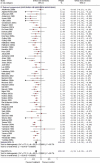Plant sterols/stanols as cholesterol lowering agents: A meta-analysis of randomized controlled trials
- PMID: 19109655
- PMCID: PMC2596710
- DOI: 10.3402/fnr.v52i0.1811
Plant sterols/stanols as cholesterol lowering agents: A meta-analysis of randomized controlled trials
Abstract
Background: Consumption of plant sterols has been reported to reduce low density lipoprotein (LDL) cholesterol concentrations by 5-15%. Factors that affect plant sterol efficacy are still to be determined.
Objectives: To more precisely quantify the effect of plant sterol enriched products on LDL cholesterol concentrations than what is reported previously, and to identify and quantify the effects of subjects' characteristics, food carrier, frequency and time of intake on efficacy of plant sterols as cholesterol lowering agents.
Design: Fifty-nine eligible randomized clinical trials published from 1992 to 2006 were identified from five databases. Weighted mean effect sizes were calculated for net differences in LDL levels using a random effect model.
Results: Plant sterol containing products decreased LDL levels by 0.31 mmol/L (95% CI, -0.35 to -0.27, P= < 0.0001) compared with placebo. Between trial heterogeneity was evident (Chi-square test, P = <0.0001) indicating that the observed differences between trial results were unlikely to have been caused by chance. Reductions in LDL levels were greater in individuals with high baseline LDL levels compared with those with normal to borderline baseline LDL levels. Reductions in LDL were greater when plant sterols were incorporated into fat spreads, mayonnaise and salad dressing, milk and yoghurt comparing with other food products such as croissants and muffins, orange juice, non-fat beverages, cereal bars, and chocolate. Plant sterols consumed as a single morning dose did not have a significant effect on LDL cholesterol levels.
Conclusion: Plant sterol containing products reduced LDL concentrations but the reduction was related to individuals' baseline LDL levels, food carrier, and frequency and time of intake.
Keywords: LDL cholesterol; food carrier; intake frequency; meta-analysis; plant sterols; single dose.
Figures



References
-
- National Cholesterol Education Program Expert Panel. Third report of the national cholesterol education program (NCEP) expert panel on detection, evaluation, and treatment of high blood cholesterol in adults (adult treatment panel III) final report. Circulation. 2002;106:3143–421. - PubMed
-
- Fletcher B, Berra K, Ades P, Braun LT, Burke LE, Durstine JL, Fair JM, Fletcher GF, Goff D, et al. Managing abnormal blood lipids – A collaborative approach. Circulation. 2005;112:3184–209. - PubMed
-
- Katan MB, Grundy SM, Jones P, Law M, Miettinen T, Paoletti R. Efficacy and safety of plant stanols and sterols in the management of blood cholesterol levels. Mayo Clin Proc. 2003;78:965–78. - PubMed
LinkOut - more resources
Full Text Sources

